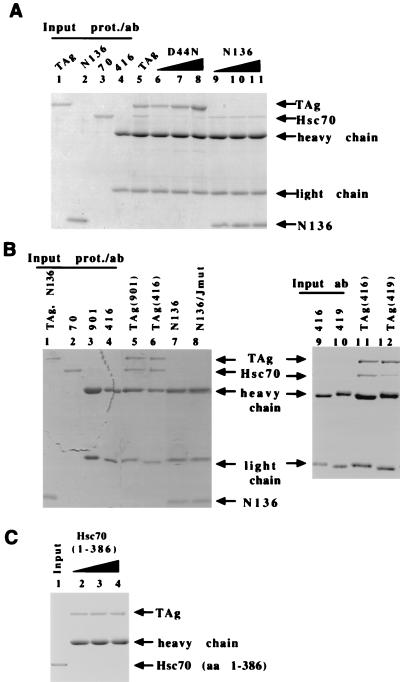FIG. 4.
Direct T-antigen–Hsc70 association requires multiple domains of both T antigen and Hsc70. (A) The J domain point mutant D44N and truncated T-antigen N136 fail to bind to Hsc70. Increasing amounts of D44N (120, 240, and 360 nM [lanes 6 to 8, respectively]) or N136 (600, 1,200, and 1,800 nM [lanes 9 to 11, respectively]) were incubated with Hsc70 and immunoprecipitated with anti-T-antigen antibody PAb416. The Coomassie blue-stained SDS-PAGE gel is shown. A positive-control reaction with wild-type T antigen (120 nM [lane 5]) is shown. Results for 50% input of Hsc70 (lane 3) or 100% input of PAb416 (lane 4) are shown. One microgram of T antigen (lane 1) and N136 (lane 2) are shown for migration markers. (B) T antigen and Hsc70 were incubated and immunoprecipitated with anti-T antigen PAb416 (lanes 7 and 11), anti-T antigen 901 (lane 5), or anti-T antigen PAb419 (lane 12). Mutants N136 (lane 7) and N136/D44N (lane 8) were incubated with Hsc70 and immunoprecipitated with PAb416. All reactions were conducted in the presence of an ATP regeneration system. Results for 50% input of T antigen and N136 (lane 1) and Hsc70 (lane 2) are shown. Results for 100% input of antibodies 901 (lane 3), PAb416 (lanes 4 and 9), and PAb419 (lane 12) are also shown. (C) Hsc70(1–386) at 300, 600, and 1,300 nM (lanes 2 to 4, respectively) was incubated with T antigen in the presence of 1 mM MgATP. Hsc70(1–386) (300 nM) is shown as a migration marker (lane 1). Abbreviations: prot., protein; ab, antibody; TAg, T antigen. Heavy chain and light chain refer to the antibody that coprecipitates in the immunoprecipitation reaction.

